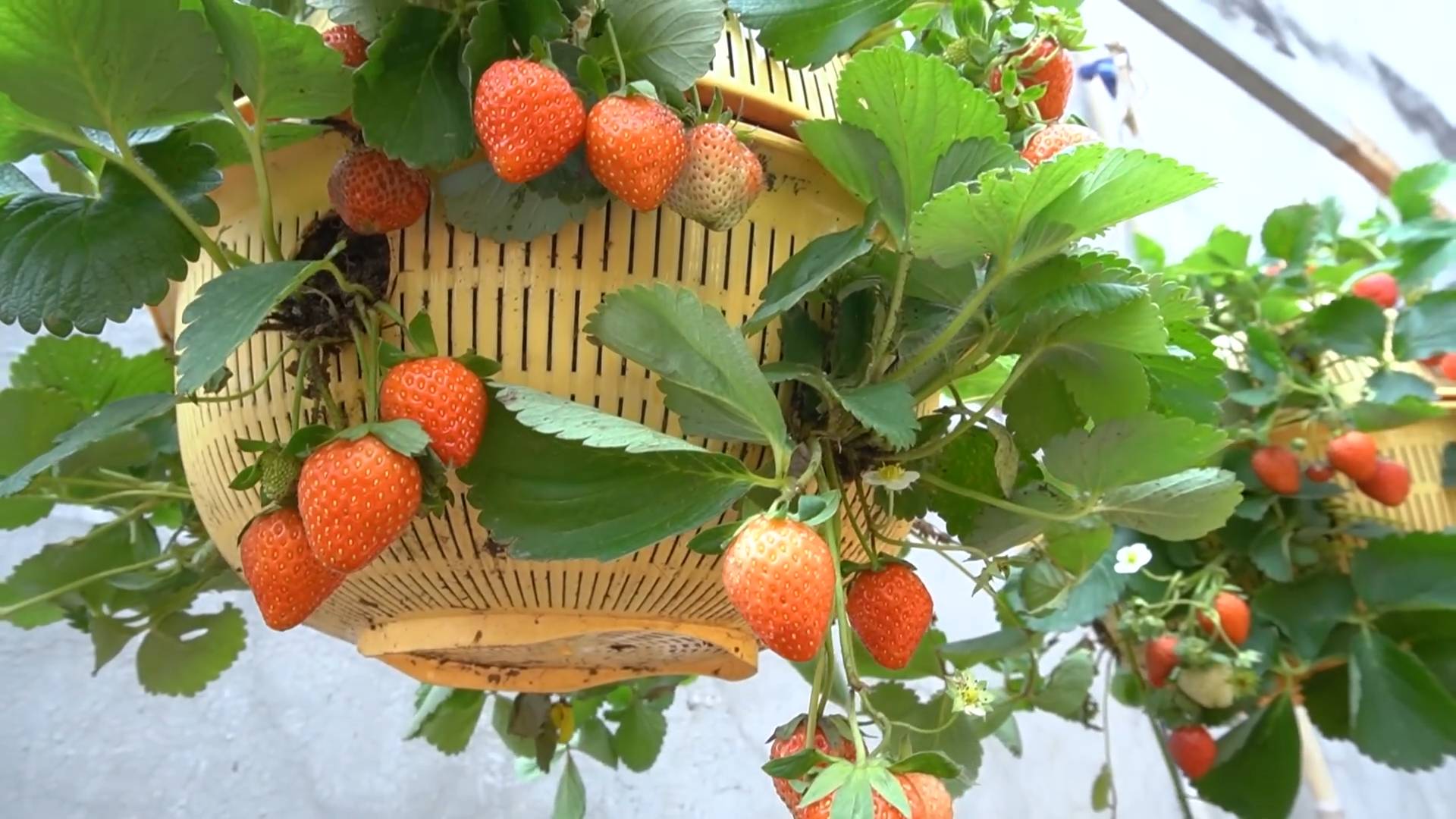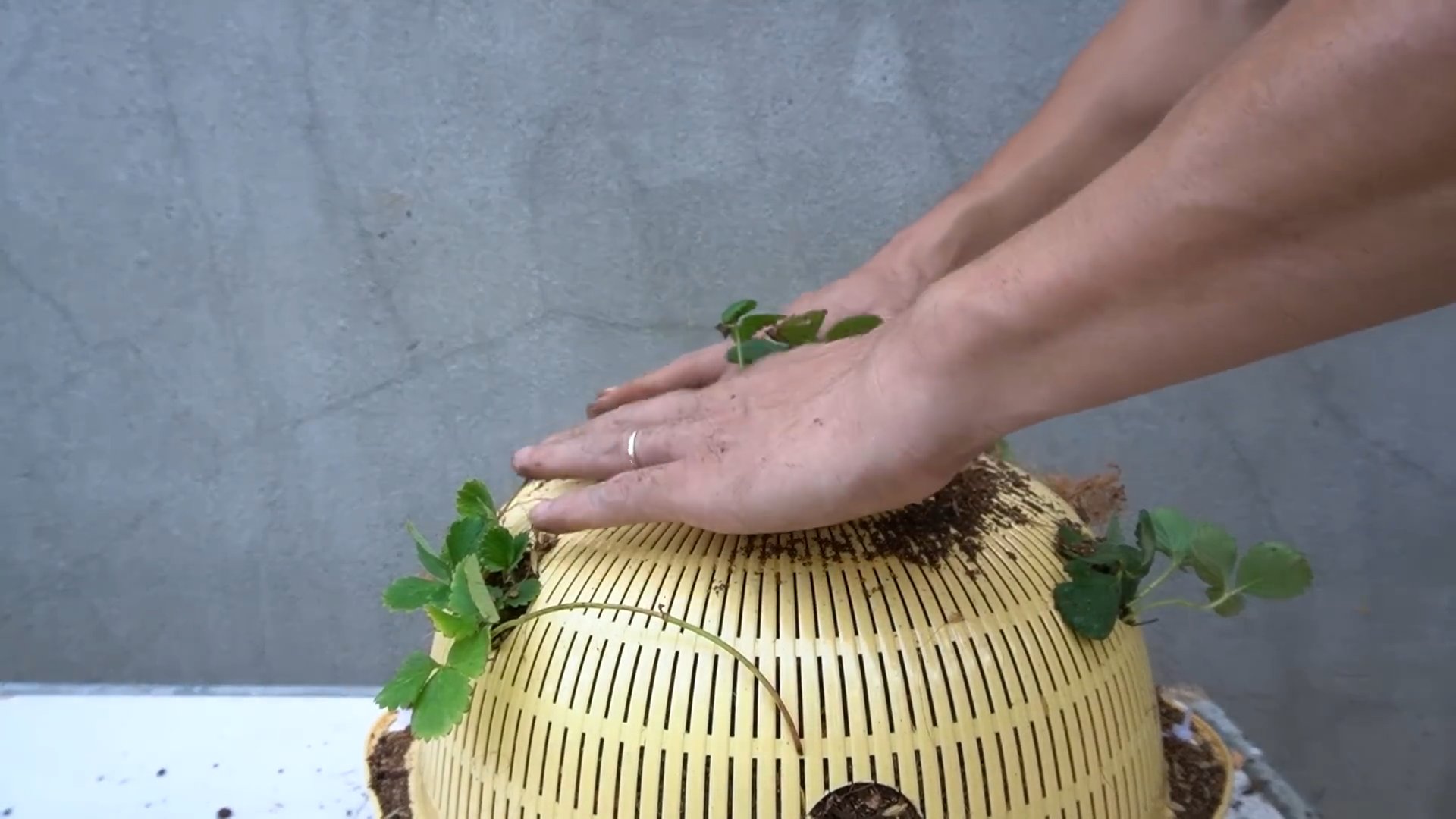Hanging strawberry plants are not just a charming addition to your home; they’re a delightful way to bring the sweet taste of summer right to your doorstep! Imagine plucking juicy, sun-ripened strawberries straight from a hanging basket – a truly rewarding experience. For centuries, gardeners have sought innovative ways to maximize space and elevate their crops, and hanging baskets offer a perfect solution, blending practicality with aesthetic appeal.
But why should you consider hanging strawberry plants? Well, beyond the sheer joy of fresh, homegrown berries, this DIY project is incredibly space-saving, making it ideal for balconies, patios, or even small gardens. Plus, hanging your strawberries keeps them off the ground, protecting them from pests and diseases. I’ve found that it also makes harvesting so much easier – no more bending and stooping! This article will guide you through simple, effective DIY tricks to create your own thriving hanging strawberry garden, ensuring you enjoy a bountiful harvest all season long. Get ready to transform your space and indulge in the sweet success of your own hanging strawberry plants!

DIY Hanging Strawberry Planters: A Sweet Treat for Your Space
Hey there, fellow gardening enthusiasts! I’m so excited to share one of my favorite DIY projects with you: creating your own hanging strawberry planters. Not only are they a fantastic way to grow delicious, fresh strawberries, but they also add a touch of charm and greenery to any balcony, patio, or even indoor space. Plus, keeping those juicy berries off the ground helps prevent pests and rot. Let’s get started!
What You’ll Need
Before we dive in, let’s gather all the necessary materials. Trust me, having everything ready beforehand will make the process much smoother.
* Strawberry Plants: Choose everbearing varieties for a continuous harvest throughout the season. I personally love ‘Albion’ and ‘Seascape’ for their flavor and productivity. You’ll need about 3-5 plants per planter, depending on the size.
* Hanging Basket or Container: You can use a traditional hanging basket, a repurposed bucket, or even a fabric grow bag. Just make sure it has drainage holes! I’ve had great success with 12-14 inch baskets.
* Potting Mix: Use a high-quality potting mix specifically formulated for containers. This will provide good drainage and aeration for your strawberry plants. Avoid using garden soil, as it can become compacted in containers.
* Coco Coir or Sphagnum Moss: This is optional, but I highly recommend it. Lining your basket with coco coir or sphagnum moss helps retain moisture and prevents soil from washing out.
* Slow-Release Fertilizer: Strawberries are heavy feeders, so adding a slow-release fertilizer to your potting mix will provide them with the nutrients they need to thrive. Look for a fertilizer specifically formulated for berries.
* Watering Can or Hose: Essential for keeping your strawberry plants hydrated.
* Gloves: To protect your hands from dirt and potential irritants.
* Scissors or Utility Knife: For trimming excess coco coir or moss.
* Hanging Hardware: If your basket doesn’t already have it, you’ll need a sturdy chain or rope and a hook to hang it from. Make sure the hook is strong enough to support the weight of the planter when it’s full of soil and plants.
* Optional: Landscape Fabric: This can be used to line the inside of your basket to help retain moisture and prevent soil from escaping.
Step-by-Step Instructions: Creating Your Hanging Strawberry Oasis
Alright, let’s get our hands dirty! Follow these steps, and you’ll have beautiful hanging strawberry planters in no time.
1. Prepare Your Basket: If you’re using a traditional hanging basket, check the drainage holes. Make sure they’re not blocked. If you’re using a repurposed container, drill drainage holes in the bottom. This is crucial for preventing root rot.
2. Line the Basket (Optional): If you’re using coco coir or sphagnum moss, soak it in water until it’s fully saturated. Then, squeeze out the excess water. Line the inside of the basket with the coco coir or moss, pressing it firmly against the sides. You can also use landscape fabric, cutting it to fit the inside of the basket and securing it with staples or glue if needed.
3. Add Potting Mix: Fill the basket about halfway with potting mix. Mix in the slow-release fertilizer according to the package instructions. This will give your strawberry plants a good start.
4. Plant Your Strawberries: Gently remove the strawberry plants from their containers, being careful not to damage the roots. Loosen the roots slightly with your fingers.
5. Arrange the Plants: Arrange the strawberry plants evenly around the basket, spacing them a few inches apart. Make sure the crown of the plant (where the leaves emerge from the stem) is above the soil line.
6. Fill with More Potting Mix: Add more potting mix around the strawberry plants, filling the basket to within an inch or two of the top. Gently press down on the soil to secure the plants.
7. Water Thoroughly: Water the newly planted strawberries thoroughly until water drains out of the bottom of the basket. This will help settle the soil and encourage root growth.
8. Hang Your Planter: Attach the hanging hardware to your basket, if necessary. Choose a sunny location for your hanging strawberry planter, preferably one that receives at least 6-8 hours of sunlight per day. Hang the planter securely from a sturdy hook or support.
Maintaining Your Hanging Strawberry Planters: Keeping Your Berries Happy
Now that you’ve created your hanging strawberry planters, it’s important to provide them with the care they need to thrive. Here’s what you need to know:
* Watering: Strawberries need consistent moisture, especially when they’re fruiting. Water your hanging strawberry planters regularly, especially during hot, dry weather. Check the soil moisture by sticking your finger into the soil. If the top inch feels dry, it’s time to water. Avoid overwatering, as this can lead to root rot. I usually water mine every other day, but it really depends on the weather.
* Fertilizing: Strawberries are heavy feeders, so they need regular fertilization. In addition to the slow-release fertilizer you added at planting time, you can also supplement with a liquid fertilizer every 2-3 weeks. Look for a fertilizer specifically formulated for berries, or use a balanced fertilizer diluted to half strength.
* Sunlight: Strawberries need at least 6-8 hours of sunlight per day to produce a good crop of berries. Choose a sunny location for your hanging strawberry planters. If you live in a hot climate, you may need to provide some afternoon shade to protect the plants from scorching.
* Pruning: Remove any dead or yellowing leaves from your strawberry plants regularly. This will help prevent disease and encourage new growth. You can also prune off runners (long, trailing stems) to encourage the plants to focus their energy on producing fruit. However, if you want to propagate new strawberry plants, you can allow the runners to root in small pots filled with potting mix.
* Pest Control: Keep an eye out for pests such as aphids, spider mites, and slugs. If you notice any pests, treat them promptly with an appropriate insecticide or organic pest control method. I’ve had good luck with insecticidal soap for aphids and diatomaceous earth for slugs.
* Winter Care: In cold climates, you’ll need to protect your hanging strawberry planters from freezing temperatures. You can bring them indoors to a sunny location, or you can wrap them in burlap or blankets to insulate them. You can also move them to a sheltered location, such as a garage or shed. Water sparingly during the winter months, as the plants will not be actively growing.
Troubleshooting: Common Strawberry Problems and Solutions
Even with the best care, you may encounter some problems with your hanging strawberry planters. Here are some common issues and how to address them:
* Yellowing Leaves: Yellowing leaves can be caused by a variety of factors, including overwatering, underwatering, nutrient deficiencies, and pests. Check the soil moisture and adjust your watering accordingly. Fertilize your plants with a balanced fertilizer. Inspect the plants for pests and treat them as needed.
* Small or Misshapen Berries: Small or misshapen berries can be caused by poor pollination, nutrient deficiencies, or pests. Make sure your strawberry plants are getting enough sunlight and water. Fertilize them with a fertilizer specifically formulated for berries. Encourage pollination by planting flowers that attract bees and other pollinators near your strawberry planters.
* Rotting Berries: Rotting berries can be caused by overwatering, poor air circulation, or fungal diseases. Avoid overwatering your strawberry plants. Provide good air circulation by spacing the plants properly and pruning off any dead or yellowing leaves. Treat fungal diseases with an appropriate fungicide.
* No Berries: If your strawberry plants are not producing any berries, it could be due to a lack of sunlight, poor pollination, or nutrient deficiencies. Make sure your plants are getting enough sunlight. Encourage pollination by planting flowers that attract bees and other pollinators near your strawberry planters. Fertilize them with a fertilizer specifically formulated for berries. Also, make sure you have an everbearing variety, as some varieties only produce one crop per year.
Harvesting Your Strawberries: The Sweet Reward
The best part of growing your own strawberries is, of course, harvesting them! Strawberries are typically ready to harvest about 4-6 weeks after flowering. Look for berries that are fully red and slightly soft to the touch. Gently twist the berry off the plant, leaving the green cap attached.
Enjoy your fresh, homegrown strawberries in salads, smoothies, desserts, or simply eat them straight from the planter! They’re a delicious and healthy treat that you can enjoy all season long.
I hope you found this guide helpful. Happy gardening, and may your hanging strawberry planters be overflowing with sweet, juicy berries!

Conclusion
So, there you have it! Transforming ordinary items into charming hanging planters for your strawberry plants is not only incredibly rewarding but also a fantastic way to maximize space and add a touch of rustic elegance to your garden or balcony. This DIY project is more than just a craft; it’s an investment in fresh, homegrown goodness and a sustainable approach to gardening.
Why is this a must-try? Because it’s economical, customizable, and undeniably fun! Forget expensive store-bought planters. With a little creativity and resourcefulness, you can create unique and eye-catching displays that reflect your personal style. Plus, the satisfaction of harvesting your own juicy strawberries from a planter you made yourself is simply unmatched.
Consider these variations to personalize your hanging strawberry planters even further:
* Vertical Pallet Garden: If you have a larger space, repurpose a wooden pallet into a vertical garden. Line the slats with landscape fabric and fill them with soil, creating multiple tiers for your strawberry plants. This is a visually stunning and highly productive option.
* Upcycled Tire Planters: Old tires can be transformed into colorful and durable planters. Paint them in vibrant hues, stack them creatively, and fill them with soil. This is a great way to recycle and add a playful touch to your garden.
* Hanging Gutter Garden: Repurpose old gutters into long, narrow planters. Hang them horizontally from a fence or railing to create a cascading effect of strawberry plants. This is a space-saving and visually appealing option for smaller areas.
* Mason Jar Magic: For a smaller, more delicate display, use mason jars as individual hanging planters. Drill drainage holes in the lids, fill the jars with soil, and hang them from a sturdy branch or hook. This is perfect for showcasing a few select strawberry plants.
* Add Companion Plants: Enhance your strawberry planters by incorporating companion plants like basil, thyme, or marigolds. These plants can help deter pests, attract pollinators, and improve the overall health of your strawberry plants.
Don’t be afraid to experiment with different materials, colors, and arrangements to create hanging strawberry planters that are truly unique to you. The possibilities are endless!
We wholeheartedly encourage you to embark on this DIY adventure. It’s a simple, cost-effective, and incredibly satisfying way to grow your own delicious strawberries. And most importantly, it’s a fantastic way to connect with nature and enjoy the fruits (literally!) of your labor.
Once you’ve created your own hanging strawberry planters, we’d love to hear about your experience! Share your photos, tips, and variations in the comments below. Let’s inspire each other to create beautiful and bountiful gardens, one DIY project at a time. Remember, growing your own food is not just a hobby; it’s a lifestyle. So, get your hands dirty, unleash your creativity, and enjoy the sweet taste of success with your very own **hanging strawberry plants**!
Frequently Asked Questions (FAQ)
What type of strawberries are best for hanging planters?
Day-neutral and everbearing strawberry varieties are generally the best choices for hanging planters. Day-neutral varieties produce fruit throughout the growing season, while everbearing varieties produce two main crops: one in the spring and another in the fall. These varieties tend to be smaller and more compact, making them well-suited for the limited space of a hanging planter. Some popular choices include:
* Albion
* Seascape
* Tristan
* Tribute
* Ozark Beauty
Avoid June-bearing varieties, as they produce a large crop all at once and may not be as productive in a hanging planter setting.
What kind of soil should I use for my hanging strawberry plants?
Use a well-draining potting mix specifically formulated for containers. Avoid using garden soil, as it can become compacted and heavy in a container, hindering drainage and root growth. A good potting mix will retain moisture while allowing excess water to drain away, preventing root rot. You can also amend the potting mix with compost or other organic matter to improve its fertility and drainage. A slightly acidic soil pH (between 5.5 and 6.5) is ideal for strawberries.
How often should I water my hanging strawberry plants?
Hanging strawberry plants tend to dry out more quickly than those planted in the ground, so regular watering is essential. Check the soil moisture daily, especially during hot and dry weather. Water thoroughly when the top inch of soil feels dry to the touch. Avoid overwatering, as this can lead to root rot. Ensure that your hanging planter has adequate drainage holes to prevent water from accumulating at the bottom. A good rule of thumb is to water deeply until water drains out of the bottom of the container.
How much sunlight do hanging strawberry plants need?
Strawberries need at least 6-8 hours of direct sunlight per day to produce abundant fruit. Choose a location for your hanging planter that receives plenty of sunlight. If you live in a particularly hot climate, provide some afternoon shade to prevent the plants from overheating. Insufficient sunlight can result in reduced fruit production and smaller, less flavorful strawberries.
How do I fertilize my hanging strawberry plants?
Strawberries are heavy feeders and benefit from regular fertilization. Use a balanced fertilizer specifically formulated for strawberries or fruits and vegetables. Follow the instructions on the fertilizer package for application rates and frequency. You can also use organic fertilizers such as compost tea or fish emulsion. Fertilize your plants every 2-4 weeks during the growing season to promote healthy growth and abundant fruit production. Avoid over-fertilizing, as this can lead to excessive foliage growth at the expense of fruit production.
How do I protect my hanging strawberry plants from pests and diseases?
Monitor your plants regularly for signs of pests and diseases. Common pests that affect strawberries include aphids, spider mites, and slugs. You can control these pests with insecticidal soap, neem oil, or by handpicking them off the plants. Diseases such as powdery mildew and gray mold can also affect strawberries. Prevent these diseases by providing good air circulation, avoiding overhead watering, and removing any infected leaves. You can also use fungicides if necessary. Consider using companion planting to deter pests naturally.
How do I overwinter my hanging strawberry plants?
In colder climates, hanging strawberry plants need protection during the winter months. You can bring the planters indoors to a cool, bright location, such as a garage or sunroom. Water sparingly during the winter, allowing the soil to dry out slightly between waterings. Alternatively, you can insulate the planters by wrapping them in burlap or bubble wrap. You can also bury the planters in the ground for added protection. In milder climates, you may be able to leave the planters outdoors with minimal protection.
How long will my hanging strawberry plants produce fruit?
With proper care, hanging strawberry plants can produce fruit for several years. However, their productivity may decline after 2-3 years. To maintain a continuous supply of strawberries, consider propagating new plants from runners. Runners are stems that grow out from the mother plant and develop roots when they come into contact with the soil. You can cut the runners from the mother plant and transplant them into new containers to create new strawberry plants.





Leave a Comment